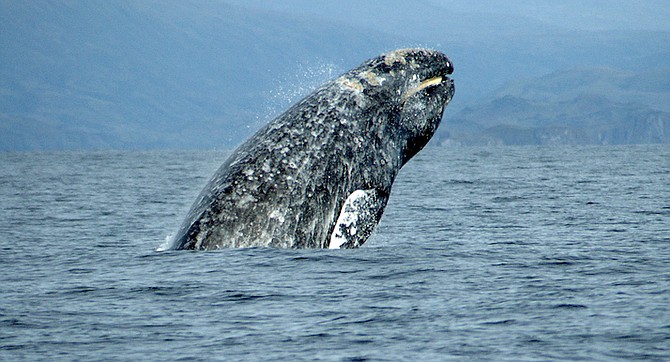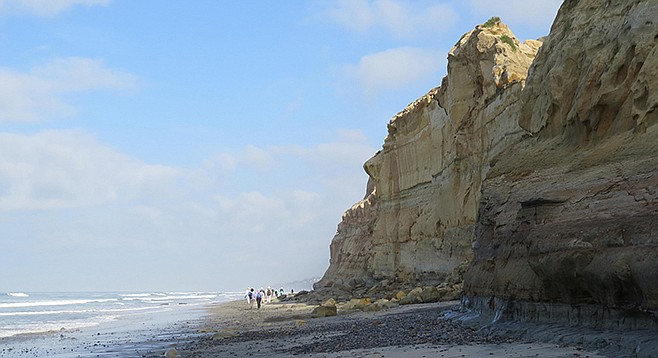 Facebook
Facebook
 X
X
 Instagram
Instagram
 TikTok
TikTok
 Youtube
Youtube

Gray Whale Migration off San Diego County’s coast peaks from now until February. The best view spots from land are high points close to the surf.
Aside from the whale watching overlook at Cabrillo National Monument, try Sunset Cliffs, the pocket parks and dead-end streets from Pacific Beach to Scripps Park in La Jolla, various ocean overlooks on the trail system at Torrey Pines State Reserve, the cliff s opposite Carmel Valley Road south of Del Mar, overlooks opposite Lomas Santa Fe Drive in Solana Beach, and various cliff-top view points and beach access stairways in Encinitas and Leucadia.
Scan the ocean a few hundred yards to a couple of miles out using high-power binoculars. Best times for viewing are about 9 a.m. to noon.

Extreme High and Low Tides will occur again in early January. On Sunday, January 2, a peak high tide of +7.56 feet occurs at 8:03 am. Monday, January 3, a high tide of +7.50 feet peaks at 8:50 am. If any strong winter storm happens to arrive from the west during these peak tides, some flooding of low-lying coastal areas around San Diego is likely.
On the optimistic side, birdwatchers have an opportunity to spot species of rare shorebirds that get pushed to the edges of local bays and coastal marshes by the high water. Several very low tides will also occur within the same string of early January dates. On January 2, the tide falls to -2.09 feet at 3:21 pm. On Monday, the tide drops to -2.01 feet at 4:07 pm. Any of these low-tide occasions are perfect for exploring marine life in the tidepool areas along San Diego County’s coastline.
After the noise and cheering at the turning of midnight tonight, step outside into the silent, cold dark. Shining high in the south will be Sirius, with the other stars of Canis Major to its right and below it. Sirius is the bottom star of the bright, equilateral Winter Triangle. The others are Betelgeuse in Orion’s shoulder to Sirius’s upper right, and Procyon the same distance to Sirius’s upper left. The Triangle stands upright, just about in balance. Happy New Year.
The above comes from the Outdoors listings in the Reader compiled by Jerry Schad, author of Afoot & Afield in San Diego County. Schad died in 2011. Planet information from SkyandTelescope.org.


Gray Whale Migration off San Diego County’s coast peaks from now until February. The best view spots from land are high points close to the surf.
Aside from the whale watching overlook at Cabrillo National Monument, try Sunset Cliffs, the pocket parks and dead-end streets from Pacific Beach to Scripps Park in La Jolla, various ocean overlooks on the trail system at Torrey Pines State Reserve, the cliff s opposite Carmel Valley Road south of Del Mar, overlooks opposite Lomas Santa Fe Drive in Solana Beach, and various cliff-top view points and beach access stairways in Encinitas and Leucadia.
Scan the ocean a few hundred yards to a couple of miles out using high-power binoculars. Best times for viewing are about 9 a.m. to noon.

Extreme High and Low Tides will occur again in early January. On Sunday, January 2, a peak high tide of +7.56 feet occurs at 8:03 am. Monday, January 3, a high tide of +7.50 feet peaks at 8:50 am. If any strong winter storm happens to arrive from the west during these peak tides, some flooding of low-lying coastal areas around San Diego is likely.
On the optimistic side, birdwatchers have an opportunity to spot species of rare shorebirds that get pushed to the edges of local bays and coastal marshes by the high water. Several very low tides will also occur within the same string of early January dates. On January 2, the tide falls to -2.09 feet at 3:21 pm. On Monday, the tide drops to -2.01 feet at 4:07 pm. Any of these low-tide occasions are perfect for exploring marine life in the tidepool areas along San Diego County’s coastline.
After the noise and cheering at the turning of midnight tonight, step outside into the silent, cold dark. Shining high in the south will be Sirius, with the other stars of Canis Major to its right and below it. Sirius is the bottom star of the bright, equilateral Winter Triangle. The others are Betelgeuse in Orion’s shoulder to Sirius’s upper right, and Procyon the same distance to Sirius’s upper left. The Triangle stands upright, just about in balance. Happy New Year.
The above comes from the Outdoors listings in the Reader compiled by Jerry Schad, author of Afoot & Afield in San Diego County. Schad died in 2011. Planet information from SkyandTelescope.org.
Comments